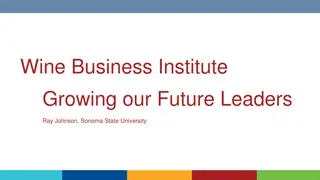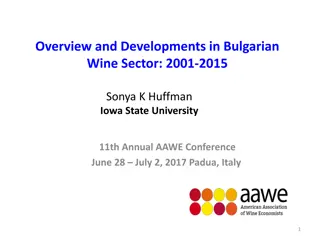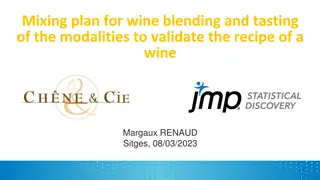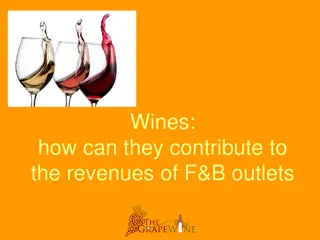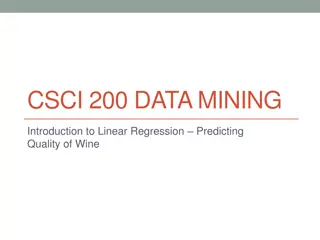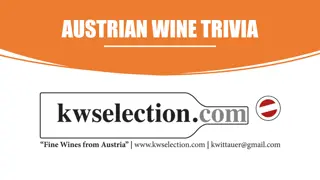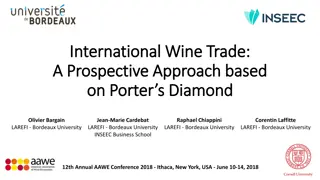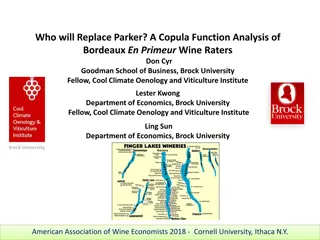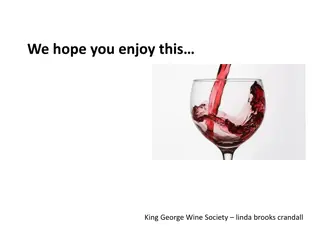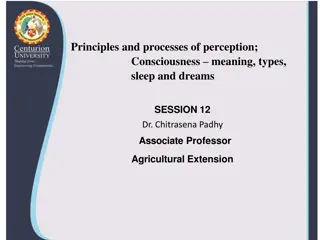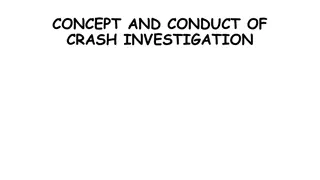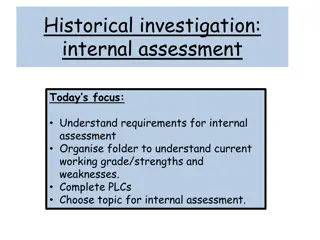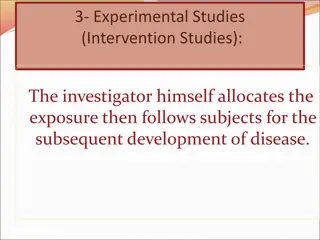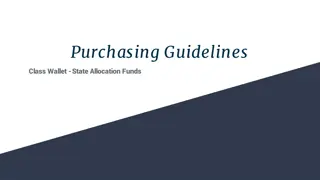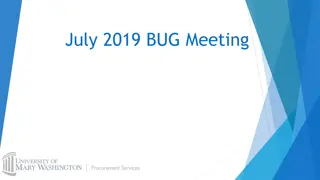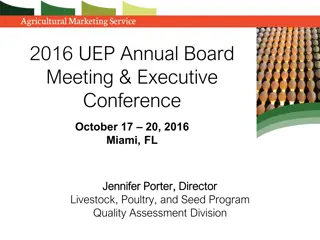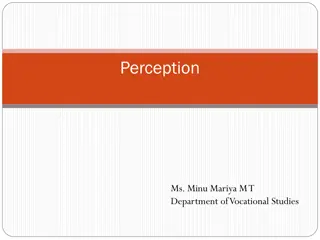Experimental Investigation of Risk Perception in Wine Purchases
The American Association of Wine Economists' 10th Annual Conference delved into consumer behavior and perceived risk when buying wine. The study explored risk, uncertainty, ambiguity, and conflict in wine purchases, presenting preliminary findings on risk-taking behaviors. An experimental investigation focused on defining contexts, designing questionnaires, and conducting empirical research among undergraduate students. The study examined risky prospects in buying wine, including functional risks like corked bottles, and surveyed students on their experience and perceived probabilities of encountering such risks.
Download Presentation

Please find below an Image/Link to download the presentation.
The content on the website is provided AS IS for your information and personal use only. It may not be sold, licensed, or shared on other websites without obtaining consent from the author. Download presentation by click this link. If you encounter any issues during the download, it is possible that the publisher has removed the file from their server.
E N D
Presentation Transcript
American Association of Wine Economists (AAWE) 10th Annual Conference in Bordeaux, France. CONSUMER BEHAVIOR AND PERCEIVED RISK: AN EXPERIMENTAL INVESTIGATION OF RISK TAKING WHEN BUYING WINE by J. Fran ois Outreville and J. Desrochers
SETTING THE STAGE 1. Definitions: risk, uncertainty, ambiguity, and conflict 2. The context of the experimental investigation 3. The preliminary results
NEXT STEP: AMBIGUITY AND CONFLICT ignorance, no information Uncertainty (analogous to the urn problem) (Ellsberg, 1961) [pmin, pmax], vagueness Ambiguity (range problem) (Curley and Yates (1985) Expert 1 1/4 1/4 (1/4 , 3/4) Expert 2 1/4 3/4 (1/3 , 2/3) Conflict Situation 1 (known risk) Situation 2 (conflict) Situation 3 (Gajdos-Vergnaud, 2013)
EXPERIMENTAL INVESTIGATION 1. Defining the context Risk taking when buying wine 2. Design of a questionnaire Hershey and Schoemaker (1980) Louberg and Outreville (2001) 3. Empirical investigation Undergraduate students, Finance, 2012 to 2014, University of Sherbrooke, Qu bec. Multiple samples
AN EXPERIMENTAL INVESTIGATION: THE CONTEXT Buying wine in a tax-free zone of an airport There is a possible functional risk (a corked wine for example)
THE RISKY PROSPECT The risky prospect is suggested by a case of 12 bottles Determination of [pmin, pmax] Students were asked if they had prior experience with a corked wine (yes = 39%) Asked to reveal their perceived probability for this risk Average 6.1% (5.0% - 7.8%)
THE EXPERIMENTS The experiments are conducted with undergraduate students in Qu bec using a questionnaire similar in structure to the one originally tested by Hershey and Schoemaker (1985) and Louberg and Outreville (2001). The context is the decision to purchase a bottle of wine (the price of which varies from $5 to $220). The risky prospect is suggested by cases of 12 bottles that may or may not contain one corked bottle SCHOOL OF WINE & SPIRITS BUSINESS 11
EXAMPLE OF QUESTIONS 1stexperiment: the effect of price on demand You want to buy a bottle of wine valued $10 but you don t know if there is a possibility that you may buy a corked bottled. Do you buy this bottle? 2ndexperiment: a risky prospect You want to buy a bottle of wine valued $10 and the manager knows that for sure there is always one corked bottle in the case of 12 (1/12). Do you buy this bottle? Experiments are distributed to different groups of students (random distribution)
THE EXPERIMENTS The total number of participants amount to 325. 36 students did not want to buy wine at all. Only a few were inconsistent in their answer (they violate the assumption of monotonicity). These were excluded from the sample. Average age between 21 and 22 51% males
PROFILE OF SUBJECTS: + QUESTIONS Attached to each questionnaire are questions dealing with: - price habits (how much do you pay for a bottle of wine?), Average $19.8 (18.3 20.8) - perceived risk for a corked bottle, - sex and age. In some of the groups participants were also asked to grade on a 5-point Likert scale how they perceived themselves compared to the group for three types of trait of character/personality: 1) are you a risk-averse/risk-seeking person?, 2) are you careful with money/spending easily money? 3) are you an optimist/pessimist person?
HYPOTHESIS 1 AND 2 People prefer known-risk to uncertainty analogous to Ellsberg s urn problem Hogarth and Kunreuther, 1989; Casey and Scholz (1991), Sarin and Weber, 1993; and more recently Pulford and Colman, 2007,2008. Some have challenged these results (Fox and Tversky, 1995; Viscusi and Chesson, 1999 ) People prefer known-risk to ambiguity in the sense of Curley and Yates (1985, 1986) Set of probabilities, interval [pmin, pmax] Di Mauro and Maffioletti (2001, 2004)
PEOPLE PREFER KNOWN-RISK TO UNCERTAINTY/IGNORANCE Demand is a decreasing function of price Questions 1 to 7 refers to prices ranging from $5 to $220 N = 75, 76
HYPOTHESIS 3: AMBIGUITY 3rdexperiment: ambiguity You want to buy a bottle of wine valued $10 but the manager knows that usually the probability that you may get a corked bottled varies between 2% and 8%. Do you buy this bottle? Experiments are distributed to different groups of students (random distribution)
PEOPLE PREFER A KNOWN-RISK TO AMBIGUITY N= 58 100.00 90.00 80.00 70.00 60.00 Known risk 50.00 Ambiguity 40.00 30.00 20.00 10.00 0.00 5 10 20 50 90 140 220
TESTING THE RANGE OF PROBABILITIES 4thexperiment: ambiguity You want to buy a bottle of wine valued $10 but the manager knows that usually the probability that you may get a corked bottled varies between 7% and 15%. Do you buy this bottle? Experiments are distributed to different groups of students (random distribution)
AMBIGUITY IS DEPENDANT ON THE LEVEL OF PROBABILITIES N= 58
HYPOTHESIS 4: CONFLICT 5thexperiment: conflict You want to buy a bottle of wine valued $10 but one sale person knows that usually the probability that you may get a corked bottled is less than 2%. Another sale person asserts that it is usually more than 8%. Do you buy this bottle? Experiments are distributed to different groups of students (random distribution)
COMPARISON OF AMBIGUITY AND CONFLICT N= 56
ROBUSTNESS: THE WILLINGNESS TO BUY AND PAY FOR A BOTTLE OF WINE The values for willingness to buy (WTB) a bottle and on the willingness to pay (WTP) for a bottle of wine are drawn from the survey. In the empirical analysis it is expected that control variables such as gender and personal characteristics of respondents affect the behaviour as well as the price habits and the perceived risk The willingness to pay for a bottle is positively related to the price habits and negatively related to the perceived risk. The higher the perceived risk, the lower is the willingness to buy. The result is consistent with the graphical analysis of the answers to the questionnaires. Specific differences exist in wine consumption behaviour between males and females (Barber et al., 2010; Bruwer et al., 2011) and it is verified in our analysis that gender (Male) and the risk seeking behaviour influence positively the willingness to pay SCHOOL OF WINE & SPIRITS BUSINESS 23
PRELIMINARY CONCLUSIONS Buying a bottle of wine is often marked by expectations and uncertainty as to its quality and subjects were given some background information on possible functional risks associated with the purchase of a bottle. The findings provide a better overall understanding of the role that perceived risk has in driving wine purchase decisions. Wine consumers are exposed to a risk environment they do not control and the process of understanding how risks are perceived by consumers may be an advantage for marketers, managers and retail assistants. Because consumers are likely to employ risk-reduction strategies, prior information given to consumers would help reduce the psychological and overall perceived risk and increase the willingness to buy.
LIMITATIONS AND POSSIBLE EXTENSIONS The study should be extended to older consumers in order to compare these results obtained for the young millennials with the other cohorts of older millennials. Next to that, given the limited buying power of students involved in this study, the other cohorts might purchase more wines and therefore, prior experience with a corked bottle of wine could be higher. Whether or not it is rational for people s decisions to be affected by probability uncertainty is a separate question. It does not necessarily imply that risk attitude is the same in all cultural environments. SCHOOL OF WINE & SPIRITS BUSINESS 25
CONSUMER BEHAVIOR AND PERCEIVED RISK Thank you for your attention and comments


